Occupy Goes Global!
Braga
In 2020 OCC! expanded its scope and encouraged students to explore local initiatives in their city, resulting in entries from various locations. Here below you find the entries from Braga
Scroll for more
In 2020 OCC! expanded its scope and encouraged students to explore local initiatives in their city, resulting in entries from various locations. Here below you find the entries from Braga
Scroll for more
Virgínia Pereira
Regenerating and rehabilitating the urban space
Once someone said that the city of Braga is the city of concrete. The historical buildings, some over fifty years old, have been left behind, and new ones are being built. And a detail that must be taken into account is that the incessant construction of new buildings takes over viable green spaces. This is happening in the city of Braga. If the reader decides, one day, to visit this city, they will find degraded, abandoned buildings, in particular in the city center. For instance, the reader will find ghostly shopping malls or barely used buildings. Nevertheless, that can change.
The new program of the City Council of Braga is the regeneration and rehabilitation of urban space, starting in the center of the city. This is and must be a priority of intervention to avoid damaging the urban landscape and reuse the buildings. Such a program involves a three-pronged intervention strategy for territorial development: technical-scientific, the real estate market, and the construction industry.
The Confiança Factory
The building of Confiança illustrates a place where urban regeneration and rehabilitation come to the top of the discussion. The future reuse of the building of Confiança has been discussed for a long time. Since production ceased, discussions intensified when the City Council of Braga acquired it in 2011. The Building of Confiança is the old headquarters of the Soap Factory and Perfumery Confiança, once a well-known factory with an impressive reputation (Guimarães, 2014). Founded in 1894, this factory remains active today and it is one of the oldest manufacturing facilities in Portugal, although it moved in 2005 to the industrial park. Located in Rua Nova Santa Cruz, in the parish of São Vítor, close to center of the city, the factory was envisioned and founded by Rosalvo da Silva Almeida and Manuel dos Santos Pereira, two residents of the city. The factory became a significant piece of people’s life. Its construction responded to an emergent situation and, consequently, conquered the society of Braga, as well as Portuguese society and later other foreign societies. Introducing a new consumer good, which no one was familiar with, the new factory produced hygiene products before the institutionalization of hygiene.
Even though it was the third largest city in Portugal, at the end of the nineteenth century, Braga was not an industrial hub. This was a rural city, traditional, conservative, and with a strong religious culture. The industrialization process in Braga was lengthy. It started with the installation of small family workshops and reached its height with the settling building of the Confiança Factory.
The building stands as a remarkable example of industrial architecture from the beginning of the twentieth century and symbolizes a close relation between society, the industrialization process, and urbanization. That’s why this building deserves to be preserved.
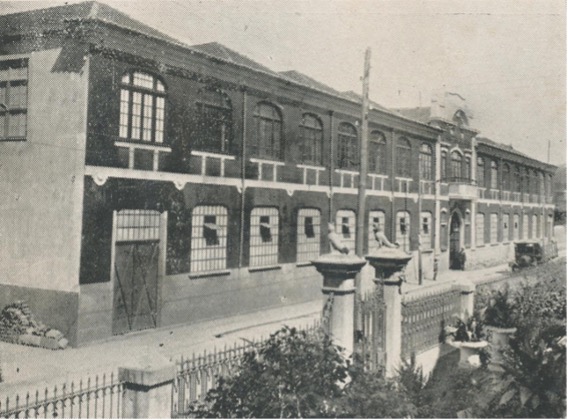
Figure 1 Confiança Factory in 1928. Source: Jornal Arquitectos
The Confiança Factory: a damaged building
Today, the Building of Confiança is a damaged edifice. Its original structure is still preserved and its original parts can be identified, despite the many changes that the building suffered throughout time. However, the building has some damage due to environmental effects and anthropogenic interference, such as pollution and graffiti.
The materials that constitute the building are timber, stone, iron, and concrete. So, its constitution is diversified and complex. Restoring this building is a difficult process, still worthwhile. The success of its restoration might depend on the reconnaissance of the damage and decay, which could reveal an advantageous strategy of treatment and intervention.
The damages observed in the building are the natural aging of the materials and the natural environmental effects, including areas damaged by waters caused by rain or rising humidity. Stains on the surface of the material are detected, as well as dirt from the outside. Graffiti is observed on the outside walls of the building, creating the impression of decay. Botanical growth can be found in the building’s biological annexation such as algae, plants, and moss. Concerning the mechanical elements, there is a loss of cohesion: some materials are being reduced to small pieces, and perforations and cracks can be found all over the building (Guimarães, 2014).

Figure 2 Building of Confiança, today. Source: (Guimarães, 2014)
Confiança is not for sale
The Building of Confiança is not for sale, in particular, to a private individual. Preventing the sale of the building to private individuals is the main objective of citizens, institutions and cultural agents of the city of Braga. These are those who already expressed their support: Academia de Teatro Tin.Bra, Arte Total, ASPA, Neighborhood Alegria Association, Braga+ CEA, Cidade Curiosa, Cineclub Aurélio da Paz dos Reis Civitas, Encontros da Imagem, Fotograma, JovemCoop, Parish Council of São Vítor, Krizo, Nova Comédia Bracarense, O cão Danado e Companhia, PIF’H, Quercus, Velha-a-Branca Estaleiro Cultural. A platform https://salvarafabricaconfianca.org/ was created to defend the building from sale and a petition was written:
The Perfumaria e Saboaria Confiança property was acquired by the City Council of Braga in 2011/2012 through a process of expropriation for public utility with the express purpose of being rehabilitated and within the scope of a broad consensus regarding the safeguarding of this landmark of Braga’s and Portuguese industry.
The investment in this industrial building has been fully paid for, not constituting any charge for the City Council, beyond the mere maintenance of the property (which, in this case, has not even occurred).
Considering that the City Council did not decide to allocate funds for its rehabilitation and that simultaneously there are several public and private entities committed to the safeguard and that together they may start a process of recovery of the property for cultural/social purposes at the service of the entire community if it is established as a priority to find an alternative solution to the hasty alienation and without public discussion.
The sale to private individuals is an irreversible act, it will represent an inestimable loss for the Parish, the city, and the Country and will mean an automatic demotion of Braga’s candidacy for the European Capital of Culture 2027.
The undersigned citizens,
Studies and news about the future reuse of the factory since the appropriation by the City Council have been disclosed, more and more often. Why the building must be well-maintained is no longer the main question, rather, it is about how it must be preserved and how to reuse the building. The City Council of Braga bought the building firstly to protect it as an industrial symbol of progress in the city. However, nothing has been done, and now, as mentioned, citizens fear that the sale of the building would signify the loss of that symbol. The City Council is taking too long to come up with a decision about the future of the factory. It was revealed that the City Council, together with the University of Minho, was working on a project to reuse the building to construct a new student residence.
Allowing the building’s deterioration, abandoning it, emptying it, brings with it environmental complications. This building degenerates over time, accumulating garbage, as a result of human activity, and as an environmental effect. Its degradation contributes to rundown urban landscapes and reduced air quality and, therefore, fragile human health.
Engaging with climate change
Urban rehabilitation and regeneration engage with the problem of climate change. Picturing the consequences of degraded buildings and responding to them can be a mitigation or adaptation strategy for climate change if cities consider how to “recycle” buildings, instead of building new ones. So, tackling climate change through rehabilitation and regeneration of urban space is possible, however alone this might not be effective and have to be applied along with other measures.
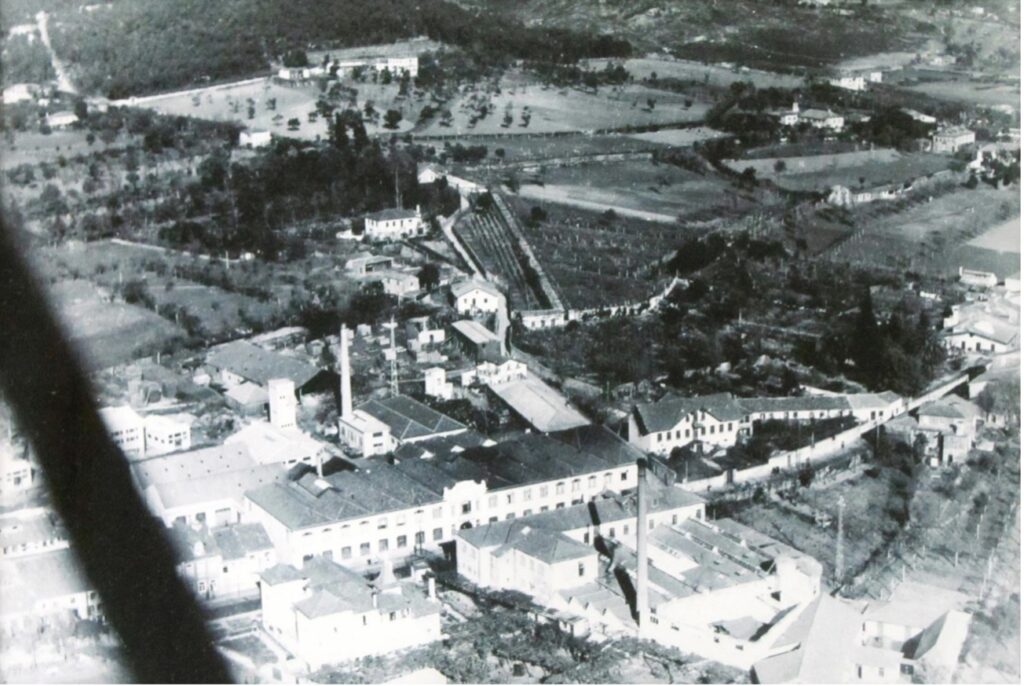
Figure 3 Aerial view of the factory (red rectangle), 1955, representing the feature of industrialization and houses and fields surrounding the large building. Source: Jornal Arquitectos
The shortcomings, the limitations, and problems
The rehabilitation and the regeneration of the Building of Confiança may effectively result in improving the urban landscape. However, shortcomings, issues, and limits can be pointed out. There are no visible effects since the City Council has not come up with a final decision about the reuse of the building and this is a major critical point, as well. The increasing deterioration of the building and the ongoing disposal of garbage limits its renewal even as the sale of the building becomes likely, and this last represents a problem for the most industrial icon of the city. Another limit is the budget available to pursue the project and the real cost of the edifice’s rehabilitation.
The physical position of the building, which is the parish of São Vítor, must be taken into consideration for its reuse due to its proximity to the city center and the existing residential buildings, the university, the mall, and small businesses nearby.
A problematic issue that might arise along with the building revitalization is conflicts of interest: that is, what is the best choice that benefits the population, and what is the real choice of the City Council?
Restoring the Confiança Building leads to broader changes
This initiative to revitalize and rehabilitate the urban space leads unequivocally to broader changes. To restore the historical city center, environmental laws must be decreed, and even in the case that the urban regeneration and rehabilitation project is recognized, there is no guarantee that environmental laws are being applied. The application of this initiative, envisioning environmental conservation, permits identifying those entities responsible to intervene in the domain of environmental quality. Still, these entities must ensure that the population, in general, participates in conserving nature, so providing access to information is a crucial point. The population can be more thoroughly prepared to reflect on issues that arise with climate and urban environment.
This initiative also promotes sustainability, that is, this project envisions improving people’s lives not by spending money on other buildings and letting existing buildings rot. It involves safeguarding a place that has a significant value to the city. This is in line with sustainable proposals, preserving the urban environment and submitting economic and industrial activities to ecological principles, satisfying the current generation, so that future generations appreciate their urban space as much as the previous ones did. Also, restoring this building, in particular, might bring more visitors to the city.
A replicable project
This initiative for the rehabilitation and regeneration of a specific urban space is replicable all over the city. The Building of Confiança is the most urgent case for intervention and is a suitable starting point to pursue this strategy. There are more buildings in the city center and its surroundings that need to be added to the project proposed by the City Council. Nevertheless, is difficult to know if those buildings are owned by the City Council, as the Building of Confiança is.
References
Braga, C. M. (s.d.). Braga, uma porta aberta para a Reabilitação Urbana. Got from Portal da Reabilitação Urbana: https://ru.cm-braga.pt/0301/reabilitacao-urbana/apresentacao
Coelho, N. (2019). A Confiança perdida é difícil de recuperar. Got from Jornal de Arquitetos: http://www.jornalarquitectos.pt/pt/forum/cronicas/a-confianca-perdida-e-dificil-de-recuperar
Coelho, N. M. (2013). O Design de Embalagem em Portugal no Século XX -do Funcional ao Simbólico – o Estudo de Caso da Saboaria e Perfumaria Confiança. Got from Repositório científico da UC: http://hdl.handle.net/10316/23803
ComUM: https://www.comumonline.com/etiqueta/fabrica-confianca/
Ferreira, A. D. (2017). A Confiança já tem uma biografia. E os seus sabonetes dão aulas de História e de Design. Got from Observador: https://observador.pt/2017/05/12/a-confianca-ja-tem-uma-biografia-e-os-seus-sabonetes-dao-aulas-de-historia-e-de-design/
Ferreira, R. (2013). A antiga Saboaria e Perfumaria Confiança. Got from Braga+: http://bragamais.blogspot.com/2013/01/a-antiga-saboaria-e-perfumaria-confianca.html
Fonseca, R. (2018). Após 100 anos de História, alienação da fábrica Confiança é decidida esta quarta-feira. Got from TSF: https://www.tsf.pt/sociedade/apos-100-anos-de-historia-alienacao-da-fabrica-confianca-e-decidida-esta-quarta-feira-9872922.html
Gomes, N. R. (2021). Cidadãos acusam Câmara de Braga de transformar a Fábrica Confiança “numa lixeira a céu aberto”. Got fom Público: https://www.publico.pt/2021/05/10/local/noticia/cidadaos-acusam-camara-braga-transformar-fabrica-confianca-lixeira-ceu-aberto-1961954
Guimarães, M. I. (2014). Industrial heritage in Northern Portugal: the example of Fábrica Confiança. Got from RepositoriUM: http://repositorium.sdum.uminho.pt/handle/1822/30613
Hasta pública da Fábrica Confiança em Braga ficou deserta. (2020). Got from Diário Imobiliário: https://www.diarioimobiliario.pt/Actualidade/Hasta-publica-da-Fabrica-Confianca-em-Braga-ficou-deserta
Parlamento defende que a Fábrica Confiança não deve ser vendida. (2019). Got from Diário Imobiliário: https://www.diarioimobiliario.pt/Actualidade/Parlamento-defende-que-a-Fabrica-Confianca-nao-deve-ser-vendida
Pereira, A. P. (2018). Fábrica Confiança: a venda que está a agitar Braga. Got from Diário de Notícias: https://www.dn.pt/edicao-do-dia/19-set-2018/fabrica-confianca-a-venda-que-esta-a-agitar-braga-9871346.html
Virgínia Pereira
When planning a community urban garden, certain issues must be considered. The first one to consider is the reason for its investment, and this involves asking about the social, economic, and environmental problems that must be faced. Then one must select the place that exhibits the most urgency in setting up a community urban garden. Defining the goals that must be achieved is a significant step for the project’s success. Another crucial point is to describe how the project engages with the climate change problem. Is this a mitigation or an adaptation strategy? Or both? Preparing urban gardening also involves financial and resource management issues, which raise a different set of questions. Who funds the urban gardening project? Who cedes the land to cultivate? For how long can beneficiaries cultivate the land provided? What kind of plants should be cultivated? What resources should be available? Who manages the garden?
The urban gardening project in Andorinhas Neighborhood, Braga
The urban gardening project in the city of Braga is an initiative of the City Council of Braga and the Environmental Fund, which is an institution that supports environmental policies and sustainable development and ensures compliance with environmental objectives and commitments. In the words of Rui Rio, Mayor of the City Council of Braga, this represents the encounter between urban reality and sustainability. The urban gardening project in the city of Braga began in 2016 and since then community urban gardens have been inaugurated in several neighborhoods in the city, such as Andorinhas Neighborhood, which was set up in 2019. The setting up of a community urban garden in the Andorinhas Neighborhood is also promoted by the Parish Council of São Vicente and the Resident’s Association of Andorinhas Neighborhood. The beneficiaries of this project are the residents of this neighborhood.
The Andorinhas Neighborhood is a social-housing neighborhood situated in São Vicente parish in Braga, Portugal. This neighborhood was built over three years, between 1983 and 1986, and comprises thirty-two residential edifices, inhabited by around two thousand people. In addition to the residential spaces, there are six shops, a multi-sport rink, a children’s playground, a workout park, and a community urban garden. The neighborhood is located in the northwest section of the city and is delimited to the south and east by Rua Fernando Castiço, to the west by Rua Dr. Pereira Caldas, and Rua Dr. Manuel Braga da Cruz, to the north and west by the uncultivated land. This is not a place that other residents of the city pass through or visit. The urban ring road, which is an important road traffic channel, composes a physical barrier between the neighborhood and the central area of the city. Crossing into the neighborhood is done through the streets below this highway, which makes it a gloomy place because of its darkness. This contributes to the characterization of this neighborhood as a marginal place. Near the neighborhood, there is no equipment or service that justifies a visit from an outside visitor. The general opinion – of inhabitants from other zones of the city – is that this neighborhood is not attractive and when visiting it, not even its green spaces are pleasant.
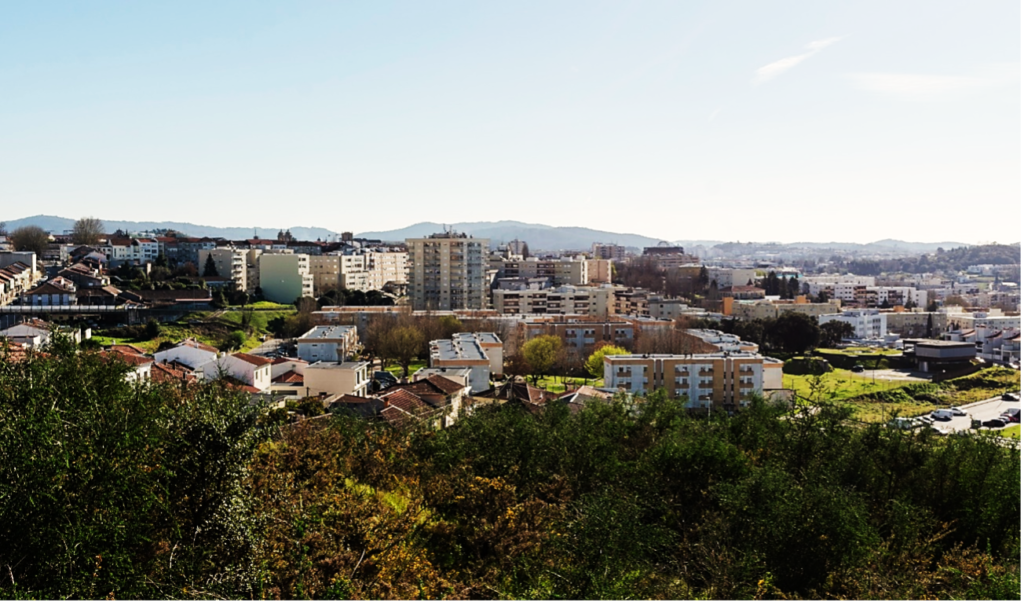
This project envisions social inclusion through inequality attenuation. Since the Andorinhas Neighborhood was built to provide shelter to those who face financial and economic difficulties, and most people who live in this neighborhood earn low wages, in some cases lower than the national minimum wage, this urban project supports an alternative to food provision. This project also promotes biological agriculture and a healthy lifestyle and encourages the conservation of biodiversity and urban nature. Besides, it aims to produce pleasant urban landscapes from an urbanistic viewpoint. Together, these goals envision the revitalization of unused spaces to benefit the population, potentiating a wider usage and also instigating a sense of community, as well as, providing environmental and ecological education.
The Andorinhas Neighborhood reveals a particularly interesting example of urban gardening due to its peripheral features and being a working-class neighborhood. The garden has an entrance and a delimited area. Its usage agreement is renewable every year and this reveals to be one of the project’s shortcomings – further clarified. One must apply to the Resident’s Association of Andorinhas Neighborhood to get a plot. The applicant must fulfill some conditions, which are: the applicant must reside in the geographical area of the parish and the proximity of her/his residence in relation to the garden is taken into account. The economic situation is essential for assessing the allocation of the land. If the application satisfies these conditions is given a plot that measures between 15 and 25 square meters. And each gardener can share a common waterpoint and a shank to keep small tools. When assigned the plot, the occupant is given a card that identifies the number of the patch and is also allowed to attend training in agriculture.
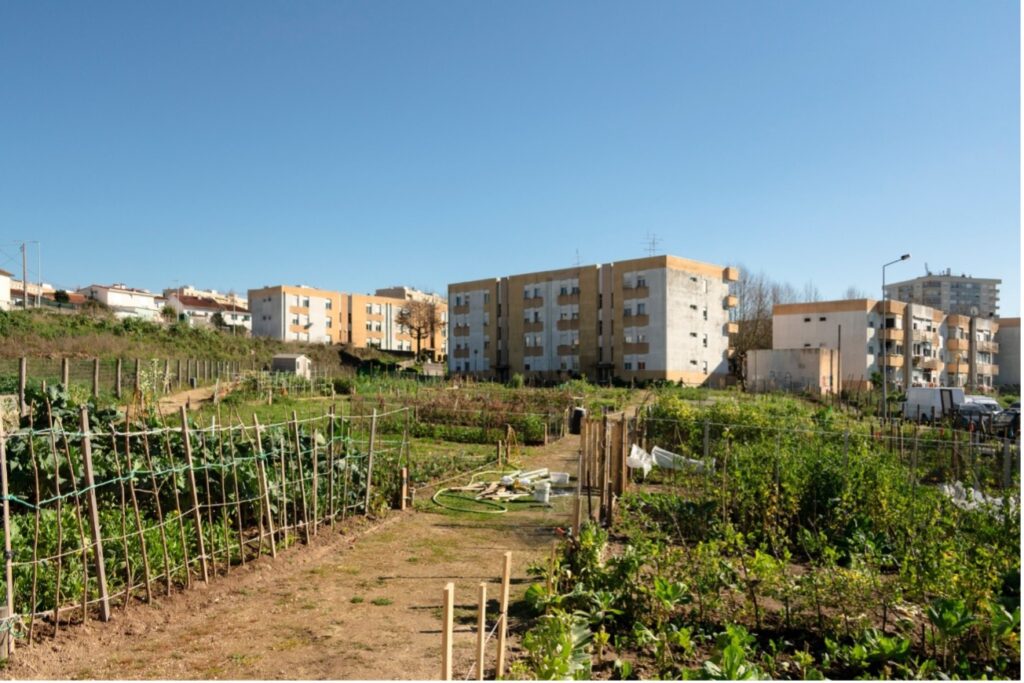
Figure 2 Community urban garden in Andorinhas Neighborhood viewed from Rua Senhora do Monte. Photo by Ana Nogueira.
A resident from the neighborhood described it as “the neighborhood of the poor, of the laborer”, the precarious neighborhood, and revealed that, in the beginning, instead of a community garden, it would be another building, perhaps a residential building. Nevertheless, between the two, as the inhabitant said, the garden was the best choice and that empty space is no longer “a pile of rubbish”. The inhabitant also confessed that “at least we have a piece of land to work and put the soup on the table” and affirmed that the community urban garden improves the urban way of life and “when there is land to cultivate there are a few vegetables to feed the family”.
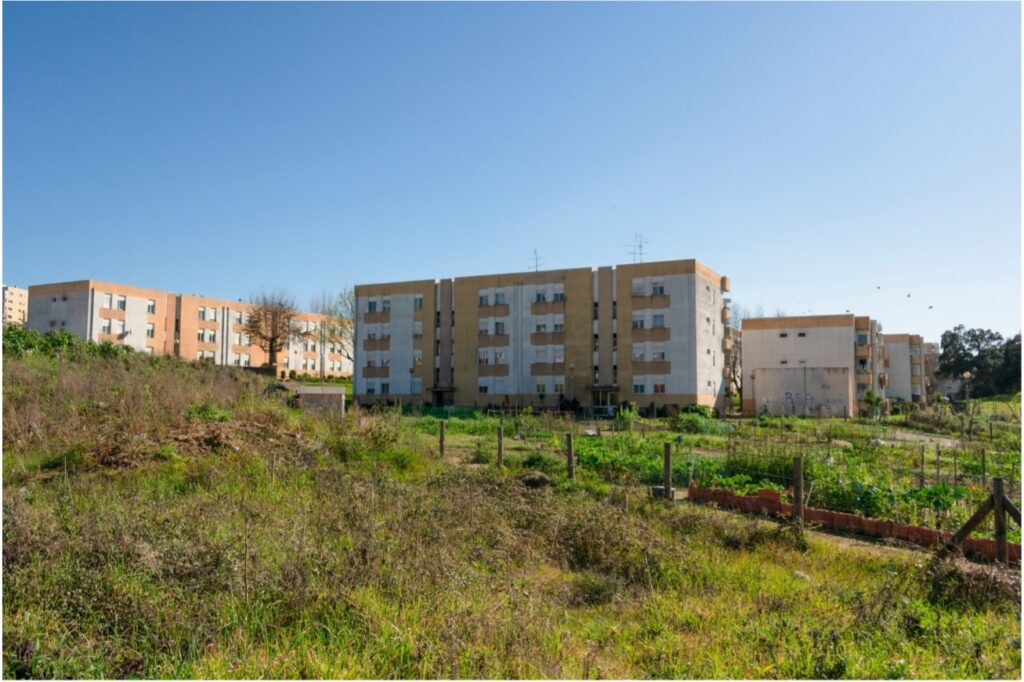
Figure 3 Community urban garden in Andorinhas Neighborhood viewed between Rua Fernando Castiço and Rua Senhora do Monte. The garden is delimited by trunks and wire and behind there is uncultivated and wasted (green) space. Photo by Ana Nogueira.
A project with shortcomings
There are shortcomings and a few critical points about the execution of this project. Starting with the cession of the space, that is, the period of time that inhabitants benefit from this project and the amount of land available. Despite the land use agreement being renewed every year, this project turns out to be ineffective to attenuate the financial and economic inequality because the dwellers are not given any certainty that they will continue to have land available to cultivate to obtain food next year. We cannot forget that plants need their own time to grow and harvest. The amount of land ceded to the community might not be enough to satisfy all population and this also fails when attempting to reduce the financial and economic inequality. The plot distribution among the beneficiaries of this initiative seems dissimilar, that is, the plots were not assigned in equal parts. However, that can be a small detail. The distribution of plots is still in progress, and this remains a problem. Either the organization and criteria of distribution are unsuitable, or the population doesn’t have the interest to cultivate the land. That is, the population hasn’t achieved yet an environmental consciousness and the entities mentioned haven’t done anything to address this issue.
Another shortcoming is garden maintenance. Despite the dwellers’ efforts, the garden is not preserved properly. At its margins, garbage can be seen. The City and the Parish Councils, together with the resident’s association, must ensure that the garden is kept clean, decreeing proper care for this space.
The usage of biofertilizers and composting must be encouraged when implementing such an urban project. The dwellers are not inspired to use biowaste or composting as a fertilizer, instead they use chemicals to grow their plants.
Considering the aesthetic point of view, the garden’s frame does not highlight any kind of beauty but rather illustrates decay. Even if the garden is no longer seen as a pleasant structure but as an alternative to obtaining food, the embellishment of the urban landscape must be taken into account.
Community resilience is a major shortcoming of this project. The same resident from the community said that everyone does according to their abilities to maintain the space. Nevertheless, “each one” seems to refer to an individual and not a member belonging to the community. This means, that the members of the community don’t come up together to maintain a clean space or elaborate an irrigation system.
The garden does not have any irrigation system. The dwellers only have a faucet and a hose to water the plants, which they share among themselves. There is no sustainable and efficient irrigation system that discharges essential amounts of water for irrigation. Also, there is no evidence of dwellers’ intentions to create one, since there are no monetary resources or they simply do not want to.
There is no evidence of continuous participation of the City Council and the Parish Council. Their participation was possibly limited only to ceding the land. The City Council and the Parish Council should continuously intervene to support the community.
Adaptation or mitigation strategy?
Due to the climate change problem, new alternatives for a living have been arranged, like installing a garden in an urban space. These alternatives are mitigation or adaptation strategies. Installing a garden in an urban space stand for an adaptation strategy by adopting a new alternative to obtain food or a mitigation strategy by being aware of food waste and consumption.
Urban gardening might be the new farming. An important lesson taken by both strategies is «take what the land gives, harvest what the land produces». This means that, although the goal is to satisfy the population, the land productivity must be taken into account, and is crucial to be alert to food consumption and waste, and overproduction because this may wash out the land and its reduction.
The urban gardening project engages with the climate change problem as a promotion of sustainability that meets urban life and stands for a resilient search for new ways to get food. The gardens give urban space a better quality of life, create more fresh air, sensibilize to food overproduction and, consequently, stimulate environmental consciousness.
A project with limitations
Some limitations interfere with the effective execution of this project. The garden’s placement constitutes a physical limit. The garden places nearby only one building and that might discourage the residents to cultivate. Another limitation might be the resident’s education level, the most did not attend compulsory education, and, therefore, may not be susceptible to learning new topics, for instance, environmental issues. The pollution around the garden hampers land conservation. So, this urban project still has no visible effects and that obfuscates the neighborhood image to the outsiders and it contributes even more to a marginal picture.
A project leading to broader changes
This initiative can lead to broader changes. It purchases the sense of community with dwellers coming up together to preserve their living urban space and work on their resilience, creating effective ways to protect their garden and urban landscape.
The urban gardening project contributes to environmental education being the keyword awareness, firstly, about the issues that have been emerging due to the problem of climate change and then in what ways that changes have impacted people’s lives.
A wider broader change is the implementation of an urban garden for all over the city adjusting to the necessities of each community.
A replicable project
This urban project is replicable, mainly in concept. This means that the implementation of urban gardens should be, unceasingly, a way of intervening in urban space due to the problem of climate change and enhancing urban landscapes. In the Andorinhas Neighborhood case, more work must be done in its design, organization, and environmental education.
References
Abertas as candidaturas para Hortas Comunitárias do Bairro das Andorinhas. (s.d.). Got from Associação dos Moradores do Bairro das Andorinhas: http://ambandorinhas.blogspot.com/
Anonymous. (February de 2022). The Community Urban Garden in the Andorinhas Neighborhood. (V. Pereira, Interviewer)
Economia Circular em Freguesias (JUNTAr+). (s.d.). Got from Fundo Ambiental: https://www.fundoambiental.pt/avisos-anteriores/avisos-2019/residuos-e-economia-circular/economia-circular-em-freguesias-juntar.aspx
Martins, S. F. (2017). Segregação socio-espacial em Braga: o caso de estudo do Bairro das Andorinhas. Repositorium: http://repositorium.sdum.uminho.pt/bitstream/1822/54435/1/Sara%20Filipa%20Lopes%20Martins.pdf
Município de Braga reforça aposta na criação de hortas urbanas. (2016). Got from de Câmara Municipal de Braga: https://www.cm-braga.pt/pt/0201/home/noticias/item/item-1-4102
Silva, J. P. (s.d.). Hortas urbanas nas freguesias de Gualtar e S. Vicente disponíveis até ao final do ano. Got from Correio do Minho: https://correiodominho.pt/noticias/hortas-urbanas-nas-freguesias-de-gualtar-e-s-vicente-disponveis-at-ao-final-do-ano/120599